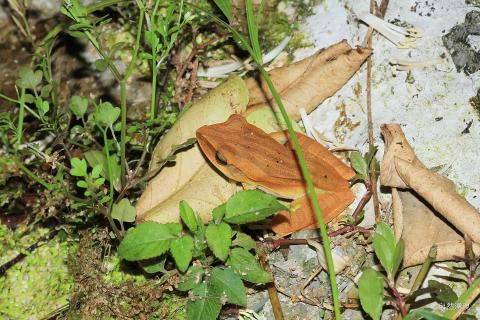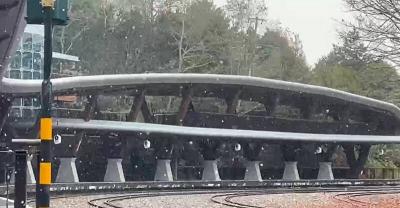The Yilan County Government has urged residents to report sightings of spot-legged tree frogs to its Agriculture Department as part of efforts to protect native tree frog species from the invasive species.
The spot-legged tree frog is native to India and Indochina. During the breeding season, the frog’s eggs attach to aquatic plants and can enter Taiwan via imported plants.
The invasive species was spotted last year in Yilan in a pond and an orchard in Dongshan Township’s (冬山) Linlikeng (淋漓坑) area.

Photo courtesy of Yilan County Government
The species has a strong reproductive ability, eats smaller frogs and competes with other tree frogs that are native to Taiwan for food, water and space.
As a result, the Forestry Bureau has identified the spot-legged tree frog as an invasive species that poses a threat.
Volunteers from Taiwan Amphibian Conservation last year removed the invasive species after it was discovered in the Linlikeng area, but after the breeding season, local groups estimated that more than 100 spot-legged tree frogs had appeared in the area this spring.
The volunteers and the county government this year ramped up their efforts to remove the species.
They captured 26 male and three female spot-legged tree frogs on March 15; 43 male and one female on March 28; and 37 male and three female and two egg masses on April 12.
Although the volunteer group removes spot-legged tree frogs every week, due to a lack of personnel, it is unable to pay attention to every detail, volunteer Lai Yung-hsien (賴擁憲) said.
The invasive species has no natural enemies, he added.
After adapting to Taiwan, it might affect the survival of native species, he said, adding that the group needs more volunteers.
Some of the frogs that were removed have been placed in the “Chaotic World — Invasive Species” exhibition at the Yilan Green Expo, which runs until May 13.
Yang Yi-ju (楊懿如), an associate professor at National Dong Hwa University Department of Natural Resources and Environmental Studies is scheduled to speak about the threat of alien tree frog species at the expo on May 12.

US President Donald Trump said "it’s up to" Chinese President Xi Jinping (習近平) what China does on Taiwan, but that he would be "very unhappy" with a change in the "status quo," the New York Times said in an interview published yesterday. Xi "considers it to be a part of China, and that’s up to him what he’s going to be doing," Trump told the newspaper on Wednesday. "But I’ve expressed to him that I would be very unhappy if he did that, and I don’t think he’ll do that," he added. "I hope he doesn’t do that." Trump made the comments in

NOT AN OPENING: Trump’s violation of international law does not affect China’s consideration in attacking Taiwan; Beijing lacks capability, not precedent, an official said Taiwanese officials see the US’ capture of the president of Venezuela as a powerful deterrent to Beijing’s aggression and a timely reminder of the US’ ability to defeat militaries equipped with Chinese-made weapons. The strikes that toppled Venezuelan President Nicolas Maduro signaled to authoritarian leaders, including Chinese President Xi Jinping (習近平), US President Donald Trump’s willingness to use military might for international affairs core to US interests, one senior official in Taipei’s security circle said. That reassured Taiwan, the person said. Taipei has also dismissed the idea that Trump’s apparent violation of international law could embolden Beijing, said the official, who was not

A cold surge advisory was today issued for 18 cities and counties across Taiwan, with temperatures of below 10°C forecast during the day and into tonight, the Central Weather Administration (CWA) said. New Taipei City, Taipei, Taoyuan and Hsinchu, Miaoli and Yilan counties are expected to experience sustained temperatures of 10°C or lower, the CWA said. Temperatures are likely to temporarily drop below 10°C in most other areas, except Taitung, Pingtung, Penghu and Lienchiang (Matsu) counties, CWA data showed. The cold weather is being caused by a strong continental cold air mass, combined with radiative cooling, a process in which heat escapes from

Snow this morning fell on Alishan for the first time in seven years, as a strong continental cold air mass sent temperatures plunging across Taiwan, the Central Weather Administration (CWA) said. The Alishan weather station, located at an elevation of about 2,200m in central Taiwan, recorded snowfall from 8:55am to 9:15am, when the temperature dropped to about 1°C, the CWA said. With increased moisture and low temperatures in the high-altitude Alishan area, the conditions were favorable for snow, CWA forecaster Tsai Yi-chi (蔡伊其) said. The last time snow fell at the Alishan weather station was on Jan. 10, 2018, while graupel fell there